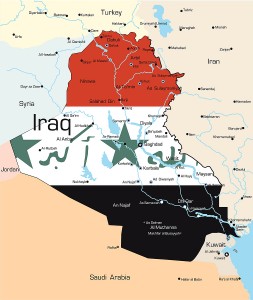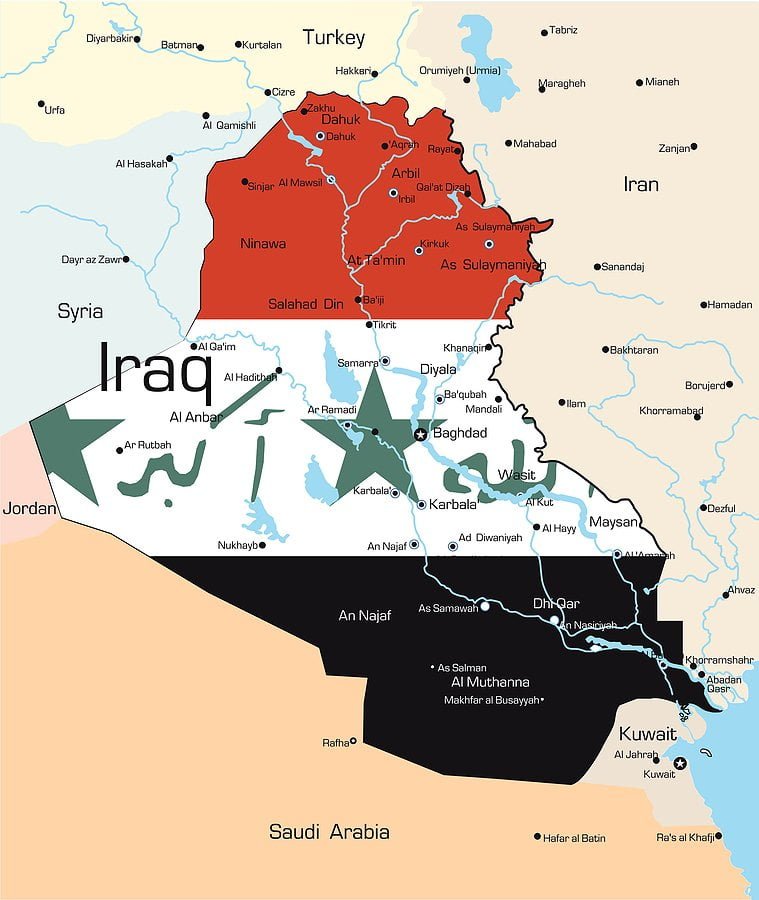2012-07-23 by Richard Weitz
June 2012 proved to be one of the most violent months in recent Iraqi history, with more than two hundred people killed in violent attacks. These attacks, for which the Islamic State of Iraq, an al-Qaeda affiliate, claimed responsibility, have continued in early July, with Shiite pilgrims providing a welcome target.
But the recent wave of bombings should not obscure that Iraq’s security conditions are worrisome but not alarming.
The number of Iraqis killed in violent attacks has remained constant at about 4,000 each year since 2009. Although obviously an unwelcome sign that Iraq will remain a dangerous country, this level of violence is much less than Iraq experienced in previous years.

More importantly, the Iraqi Security Forces (ISF) does not confront a well-organized internal foe capable of securing territory or overthrowing the regime by force. Although various insurgent groups are able to detonate bombs targeting police officers and hapless civilians, they are no longer able to hold Iraqi territory. And Iraq’s neighbors, though perhaps uneasy about the course of events, have refrained from intervening by sending conventional military forces into the country. But neither of these conditions is predestined to last forever.
The territorial integrity of a sovereign Iraq is also far from secure.
An expansive and petroleum-rich border-region with Iran has led to several minor border skirmishes over doubly claimed oil fields. A porous border with Syria has resulted in refugee outflows and heated exchanges over political espionage and unsolved terrorist attacks, further compromising Iraqi security. Repeated incursions by the Turkish military against suspected militants in Iraqi Kurdistan have also complicated Turkish-Iraqi relations.
One of the first acts of the U.S.-led occupation authorities in May 2003 was to dissolve Saddam Hussein’s military. This decision was justified on both moral and pragmatic grounds, but it had the unfortunate effect of inducing many newly unemployed but armed young men to become insurgents. Insurgent attacks and bombings subsequently grew steadily in 2004 and 2005. By 2006, the sectarian tensions between Iraq’s majority Shiite population, suppressed for years by Saddam Hussein’s oppressive regime, and its heretofore politically dominant Sunni minority had erupted into a civil war. The Iraqi army was by now heavily Shiite, as was the Baghdad police force, which only helped intensify the sectarian conflict. Only in 2007, following a surge of U.S. combat troops into the country and the adoption of a population-centric counterinsurgency doctrine, did the sectarian violence begin to subside.
The U.S. subsequently worked with Iraqi authorities to recreate an effective Iraqi military force. Whereas Iraq did not have a functioning army, air force or navy in 2003-2004, the ISF now number more than 700,000 people in the aggregate, if one includes their marine corps and various federal and local police forces. Iraq has an active military force of about 250,000 personnel, 238,000 of which are with the Army. The Army contains one armored division, ten mechanized infantry divisions, two Presidential brigades, one infantry division as well as one light infantry division, two Special Forces brigades, and one brigade assigned specifically to Baghdad
The U.S. troop surge, which allowed for aggressive operations to secure Baghdad and other urban centers, was only one element leading to the stabilization of violence in Iraq. Also contributing to the counterinsurgency efforts were the Sunni Awakening movement, which reflected the gradual emergence of Sunni opposition to the brutal and often indiscriminant attacks carried out by al-Qaida in Iraq (AQI) and other radical groups.
Beginning in Anbar province, sheikhs that had formerly led their fighters against U.S. and Iraqi forces began to cooperate with them by providing local security and intelligence information. American forces, and eventually the Iraqi government, paid these valuable allies regular salaries under the Sons of Iraq program and benefited from their contributions to internal security.
Equally important, the Iraqi government’s credibility and that of the ISF was boosted immeasurably in 2008 when Prime Minister al-Maliki, who had hesitated to move against prominent Shiite militia leaders and was accused of sectarian parochialism, boldly decided to conduct military offensives against Moqtada al-Sadr’s Jaysh al-Mahdi (JAM) militia units in Basra, Baghdad and Mosul.
This demonstrated commitment to enforcing the rule of law in an impartial and national manner inspired confidence in the central government, winning over skeptics and Sunnis. Al-Sadr soon called on his followers to observe a ceasefire, which contributed to a sharp reduction in Shiite-initiated violence. Many former Shiite fighters moved into mainstream political life to advance their distinct agendas. Meanwhile, on the Sunni side, domestic and foreign recruiting for AQI significantly decreased.
Despite the significant security improvements, militants continue to carry out attacks in Iraq.
Al Qaeda-affiliated groups such as Al Qaeda in Iraq (AQI) and the Islamic State of Iraq (ISI) have been claiming responsibility for recent bombings in the region. A senior Obama administration official also noted AQI “had not altered a pattern of cyclical violence over the past two years.” AQI was formed as an initial reaction to the U.S.-led invasion in 2003. Established by Abu Musab al-Zarqawi, an Arab of Jordanian descent, AQI always included many Syrians, Saudis, Jordanians and Yemenis, and is currently increasingly active in Syria as well. Zarqawi was often identified as al-Qaeda’s lead operator in Iraq and was in regular communication with Osama Bin Laden.
However, Zarqawi is reported to have had several disagreements with top officials on strategic and ideological matters. The most notorious attacks linked with Zarqawi and AQI include the March 2004 Madrid bombings the November 2005 Amman suicide bombings, and numerous attacks in Basra and on Shiite worshippers.
After the death of Zarqawi, AQI was known to have played a vital role in developing the ISI, which shared AQI’s objectives and tactics. AQI has developed over the years. It was initially dominated by Zarqawi’s networks from Pakistan and Afghanistan, but later participants joined from Iraq and its Middle East neighbors. For a while, AQI sought to soften its image among Iraqi civilians. AQI is now reaching out to Sunnis using financial incentives, while agitating among disgruntled Sons of Iraq members, many of whom have yet to receive promised jobs in government ministries or in the ISF. In a further indication of the group’s adaptability, AQI released a sort of “counter-counterinsurgency” manual in 2010 that calls for a full-scale media and psychological war. AQI has since conducted a series of attacks in Iraq from 2007 until now on Shiite and Iraqi government targets. In March 2012, ISI claimed responsibility for a string of attacks across the country that killed more than 50 people and injured several hundred more. They have pledged more violence against Shiites, defining them as their main enemy along with the Iraqi government, which they see as Shiite-run.
Other armed Sunni groups active in Iraq include the Jaysh al-Islami, the 1920s Revolutionary Brigade and the Jaysh Rijal al-Tariq al-Naqshabandi. Many of these groups include former Baathists and remnants of the old Sunni insurgency dating back to the aftermath of the invasion. Meanwhile, Iran funds a variety of radical Shiite militias, including the Promised Day Brigade, splinter groups from the old JAM and Kata’ib Hizbollah. While mainstream Sadrists and members of Asaib Ahl al-Haqq have largely laid down their arms, these more radical groups remain active in southern Iraq and in urban areas as the most militant opponents of the government.
Some of the recent upsurge in violence may be related to the Sunni-backed uprising in neighboring Syria.
Initially the Syrian strife might have benefitted Iraq by leading Iraqi-based Sunni terrorists to take up arms against the Assad regime in Damascus. But it is possible that a reverse flow is occurring, with the terrorists shipping some of the many weapons and trained fighters in Syria back to Iraq. The success of the Syrian uprising might also be encouraging some Iraqi extremists to resume their insurgency in Iraq.
That said, suspicions are widespread that some of the recent violence is related to the current political infighting, with disgruntled Sunnis seeking to coerce the Shiite-dominated government of al-Maliki to share greater power with its opponents and partisans of al-Maliki aiming to encourage the security forces to take an even harder line towards its opponents.
Despite the recurring activity of some of these insurgent groups, the new Iraqi army has achieved the capacity to deny militants control over any major geographic area, forcing any remaining fighters to engage in acts of terrorism against civilians and other weaker targets.
And this has occurred despite the withdrawal of all U.S. combat forces and months of political uncertainty due to the inconclusive election results and protracted coalition formation, which have prevented Iraq’s government institutions from reaching decisions to address the country’s present security problems.


